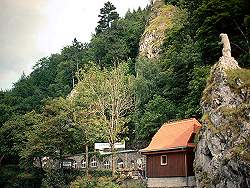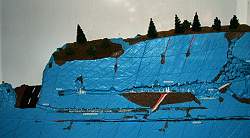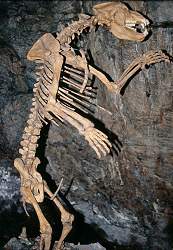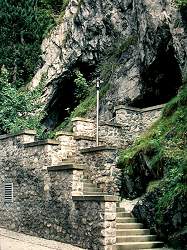Hermannshöhle
Hermann’s Cave
Useful Information



| Location: |
Hasselfelder Str. 2, 38889 Oberharz am Brocken OT Rübeland.
In Rübeland, 14 km south Wernigerode. From Wernigerode F244 to Elbingerode, turn left, F27 to Rübeland. At the main road of Rübeland towards Rappbode-Stausee. (51.7551382, 10.8472132) |
| Open: |
FEB to JUN daily 9-16:30. JUL to AUG daily 9-17:30. SEP to OCT daily 9-16:30. NOV to JAN daily 9-15:30. One of the caves closed for renovation every year during the winter months (NOV to APR). End time is time of last tour. [2024] |
| Fee: |
Adults EUR 9.50, Children (4-14) EUR 6.50, Children (0-3) free. [2024] |
| Classification: |
 Karst Cave partly marble, horizontal cave,
lower Devon. Karst Cave partly marble, horizontal cave,
lower Devon.
|
| Light: |
 Electric Light Electric Light
|
| Dimension: | L=2,733 m (3,000 m), A=378 m asl |
| Guided tours: |
L=1,300 m, D=50 min. V=100,000/a [2005]. |
| Photography: | forbidden |
| Accessibility: | many stairs, not wheelchair accessible |
| Bibliography: |
Fritz Reinboth (2016):
Zur Entdeckungsgeschichte der Hermannshöhle in Rübeland im Lichte der Originaldokumente bis 1888,
Mitteilungen des Verbandes der deutschen Höhlen- und Karstforscher e.V. 62. Nr. 2, 2016, S. 36–46.
|
| Address: |
Tourismusbetrieb Oberharz am Brocken, Blankenburger Straße 35, 38889 Oberharz am Brocken OT Rübeland, Tel: +49-39454-49132.
E-mail: |
| As far as we know this information was accurate when it was published (see years in brackets), but may have changed since then. Please check rates and details directly with the companies in question if you need more recent info. |
|
History
| 28-JUN-1866 | discovered during road works by Wilhelm Angerstein, nicknamed Sechserding, and called Sechserdinghöhle. |
| 1870 | intensive exploration by Privy Councillor Hermann Grotrian. |
| NOV-1887 | explored by Johan Herman Kloos. |
| 29-DEC-1887 | breakthrough to the upper cave into the "Bärenhöhle" by forester Tiemann. |
| 1888 | Robert Nehring is now responsible for Rübeland in the Blankenburg forestry office and takes over the exploration, surveying and construction of an access tunnel from the horse stables. |
| 01-MAY-1890 | opened as a show cave, electric light. |
| 1932 | explored by Friedrich Stolberg. |
| 1949 | extension of the tour path. |
| 1970 | new discoveries. |
Description








Hermannshöhle (Hermann’s Cave) is the larger and geologically more interesting of the two Rübeland show caves. It has three levels, at the bottom an active river cave with a cave stream, most of which can only be entered with diving equipment. Exploration by cave divers has extended this level in recent years.
Visitors enter the cave on the middle level and ascend to the top level during the tour, where they leave the cave again. One of the cave’s attractions, the Kristallkammer (Crystal Chamber), is located on the middle level. Filigree, snow-white crystals of calcite have formed here in the stagnant water. Such crystals are quite rare in Germany, so there are only a few show caves that can offer something like this.
A large number of bones were found on the top level, mostly from cave bears (Ursus spelaeus). Some bear skulls and other bones can be seen during the tour. But the highlight here is a replica of a cave bear standing erect, which illustrates its extraordinary size of almost 3.5 m. This skeleton was acquired a few years ago, it is actually not from this cave.
A man-made cave lake at the highest point of the cave is the second major attraction.
It contains living
 Olm Proteus anguinus
from Slovenia.
5 specimens were introduced in 1932 and a further 13 specimens in 1956.
Hermann’s Cave is the only place in Germany where you can see living olms from Slovenia.
This goes back to the Rübeland cave director Bernhard Lange and the geologist Dr Walter Biese.
They organized the transfer and also the construction of the so-called Olmensee, an artificial lake.
The animals which were settled in 1932 came from the
Olm Proteus anguinus
from Slovenia.
5 specimens were introduced in 1932 and a further 13 specimens in 1956.
Hermann’s Cave is the only place in Germany where you can see living olms from Slovenia.
This goes back to the Rübeland cave director Bernhard Lange and the geologist Dr Walter Biese.
They organized the transfer and also the construction of the so-called Olmensee, an artificial lake.
The animals which were settled in 1932 came from the
 Postojnska Jama.
The second time it was the Rübeland cave explorer couple Wolfgang and Ingeburg Reichel who brought 13 more olms from
Postojnska Jama.
The second time it was the Rübeland cave explorer couple Wolfgang and Ingeburg Reichel who brought 13 more olms from
 Postojnska Jama
to Rübeland.
After quarantine, the olms were finally released into the lake in January 1957.
Postojnska Jama
to Rübeland.
After quarantine, the olms were finally released into the lake in January 1957.
As they have been living in the cave for many years, it was always expected that they would eventually reproduce. The disappointment was great when they did not. Someone claimed that they were only male animals and therefore could not reproduce. In fact, socialist Yugoslavia had got into the habit of only releasing male animals, precisely to prevent them from reproducing. Even the status as a "socialist brother country" did not help. Later the import of further animals was no longer possible for conservation reasons. Others speculated that the temperature of the water of 7 °C was too low. In fact, reproduction is temperature-dependent; above 18 °C, no development of eggs and larvae is possible. As olms do not normally colonize karst waters below 10 °C, there could also be a limit here. In fact, both speculations turned out to be untrue: after the concreted basin was completely overhauled in 2015, especially when it was brought into a much more natural state, clutches of eggs appeared soon afterwards. This has now happened three times, in 2016, 2017 and 2020, so it was simply too uncomfortable for sex before. However, all of these eggs died after a while, and since this has already happened three times, there is a good chance that it is actually too cold. Although they live to a fairly advanced age of 70 to 100 or perhaps even 150 years, the time in which you can still see olms in Germany is therefore limited.
This is the younger of the two show caves in Rübeland. It was first discovered on 28-JUN-1866 by Wilhelm Angerstein, nicknamed Sechserding, a road warden from Neuwerk. He is referred to with bombastic titles, but in fact he was simply a road worker and maintained the roads and paths in the area. He was clearing rubble and debris on the mountain side of the Hasselfelder Straße when he discovered the entrance. The cave was therefore named after his nickname, Sechserdinghöhle. It is unclear exactly what work he carried out; early sources mention the construction of the road from Rübeland to Hasselfelde, a task that he certainly could not have accomplished alone. However, there are also sources that indicate that Fritz Sorge from Rübeland, who was considerably slimmer, travelled through the narrow cave entrance first and should therefore be considered the discoverer. Angerstein only entered the cave after the narrow entrance had been widened. There is also a source that refers to an unnamed smelter worker as the discoverer. This version is also supported by the fact that the chief smelter inspector Bredenschey had the cave sealed with a door the very next day, according to his own statement. This is the reason why both the speleothems and the contents of the cave are so well-preserved. A few weeks later, he reported in a letter to the Ducal Chamber, Directorate of Mines in Brunswick. He requested a licence from the municipality to use the cave for guided tours, and the municipality was even prepared to pay a reward to the discoverer. The latter had himself made representations to the ducal district administration in Blankenburg, which in turn enquired with Bredenschey. The main problem was at first that the narrow entrance, the 10 m deep shaft and the following low passage required massive development work at high cost.
The whole discussion was based on the fact that the cave was located on manorial land and therefore belonged to the resort of the Ducal Chamber of D. d. B.. The municipality would have liked to buy it and run it itself, because the two other show caves in Rübeland were already very profitable and supported four full-time cave guides. However, this was rejected and the cave was to be preserved in its original state for scientific purposes. The first investigations began in 1870 by the Brunswick Privy Councillor Hermann Grotrian. In the following years, he studied the fossils in the cave. The State Ministry approved Grotrian’s application for research funds and provided him with 100 Reichstaler in 1874. This is probably the reason why this year is usually cited for his research, but he had already been exploring the cave from 1870. However, these soon came to a halt again due to his age. The entomologist Fuchs from Berlin applied to search for eyeless insects and was referred to Grotrian. However, nothing was published, Grotrian was probably somewhat dismissive. Grotrian commissioned a surveyor to measure the cave and three workers and a miner to make the cave "navigable". He also seems to have been so eager for recognition that he named the cave after himself. Grotrian himself commissioned a bronzed, cast-iron plate, including a "screw-on", from the Harz works. This was erected on 29-JUN-1877, the anniversary of the discovery, so to speak, and thus facts were created. The inscription read: "29 June 1877 Hermann’s Cave". Grotrian had already died by this time.
In October 1887, Grotrian’s successor, Kammerrat Kybitz, commissioned Johan Herman Kloos, a professor at the Technical University of Braunschweig, to investigate a small cave discovered in the Weserbergland. The existence of the Hermannshöhle cave was now rediscovered and Kloos also investigated it. Under his supervision, the local forester Tiemann, supported by the forest warden Hase, began new excavations in November 1887. In the same year, he discovered the connection to the Bärenhöhle, the higher level. From 1888, however, Robert Nehring was responsible for Rübeland at the Blankenburg forestry office. He took over the exploration, surveying and construction of an access tunnel from the horse stables. The discovery of the higher floor and the precise surveying were the prerequisites for the development of the cave as a show cave. And so it took almost a quarter of a century until the cave was finally opened as a show cave on 01-MAY-1890. However, it already had electric light when it opened, making it the second show cave with electric light in Germany. At that time, there were only half a dozen show caves with electric light in the world.
A large number of bones were found when the cave was converted into a show cave. The cave became famous for the numerous cave bear bones found here. But bones of cave lions, hyenas, mountain hares and ptarmigans have also been found.
The two show caves in Rübeland are run by a single administration. Over the years, many rather strange peculiarities of the former GDR administration have been eradicated, making cave visits very relaxed. Unfortunately, Corona had devastating effects. For example, the opening hours are only given for the current and next month, and tickets are sold via the online booking system. This does not offer discounted tickets for senior citizens, students or families, nor are combined tickets for both caves sold any more. However, it seems that the sale at the cave ticket office still exists.
 First Caves with Electric Light
First Caves with Electric Light Search DuckDuckGo for "Baumannshöhle"
Search DuckDuckGo for "Baumannshöhle" Google Earth Placemark
Google Earth Placemark Hermann’s Cave - Wikipedia (visited: 31-JAN-2024)
Hermann’s Cave - Wikipedia (visited: 31-JAN-2024) The Hermanns Cave, official website (visited: 31-JAN-2024)
The Hermanns Cave, official website (visited: 31-JAN-2024)
 Index
Index Topics
Topics Hierarchical
Hierarchical Countries
Countries Maps
Maps